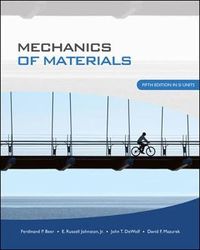
2 säljare
Mechanics of Material (Asia Adaptation) Upplaga 5
overview
This text is designed for the
first course in mechanics of materials or strength of materials offered to
engineering students in the sophomore or junior year. The main objective is to
help develop in the engineering student the ability to analyse a given problem
in a simple and logical manner and to apply to its solution a few fundamental
and well-understood principles. In this text, the study of the mechanics of
materials is based on the understanding of a few basic concepts and on the use
of simplified models. This approach makes it possible to develop all the
necessary formulas in a rational and logical manner and to clearly indicate the
conditions under which they can be safely applied to the analysis and design of
actual engineering structures and machine components.
features
New and revised problems
Hands-On Mechanics: Helps the
professor build in-class experiments that demonstrate complicated topics in
the text. The experiments and instructions are posted on
www.handsonmechanics.com.
McGraw-Hills ARIS
(Assessment, Review and Instruction System): A complete, online tutorial,
electronic homework and course management system, designed for greater ease
of use than any other system available. For students, ARIS contains
self-study tools such as animation and interactive quizzes, and it enables
students to complete and submit their homework online. For instructors, ARIS
provides teaching resources online, and allows them to create or edit
problems from the question bank, import their own contents, and grade and
report easy-to-assign homework, quizzes and tests. ARIS is free for
instructors, while students can purchase access from the bookstore or the
ARIS website. (See
http://mharis.mhhe.com for details)
Upplaga: 5e upplagan
Utgiven: 2009
ISBN: 9780071284226
Förlag: McGraw-Hill Education / Asia
Format: Häftad
Språk: Engelska
Sidor: 816 st
overview
This text is designed for the
first course in mechanics of materials or strength of materials offered to
engineering students in the sophomore or junior year. The main objective is to
help develop in the engineering student the ability to analyse a given problem
in a simple and logical manner and to apply to its solution a few fundamental
and well-understood principles. In this text, the study of the mechanics of
materials is based on the understanding of a few basic concepts and on the use
of simplified models. This approach makes it possible to develop all the
necessary formulas in a rational and logical manner and to clearly indicate the
conditions under which they can be safely applied to the analysis and design of
actual engineering structures and machine components.
features
New and revised problems
Hands-On Mechanics: Helps the
professor build in-class experiments that demonstrate complicated topics in
the text. The experiments and instructions are posted on
www.handsonmechanics.com.
McGraw-Hills ARIS
(Assessment, Review and Instruction System): A complete, online tutorial,
electronic homework and course management system, designed for greater ease
of use than any other system available. For students, ARIS contains
self-study tools such as animation and interactive quizzes, and it enables
students to complete and submit their homework online. For instructors, ARIS
provides teaching resources online, and allows them to create or edit
problems from the question bank, import their own contents, and grade and
report easy-to-assign homework, quizzes and tests. ARIS is free for
instructors, while students can purchase access from the bookstore or the
ARIS website. (See
http://mharis.mhhe.com for details)
Begagnad bok
485 kr
Fri frakt & skickas inom 1-3 vardagar
Köpskydd med Studentapan
Varje köp täcks av Studentapans köpskydd som säkerställer att boken kommer fram, att du får rätt bok och att skicket stämmer överens med beskrivning.



